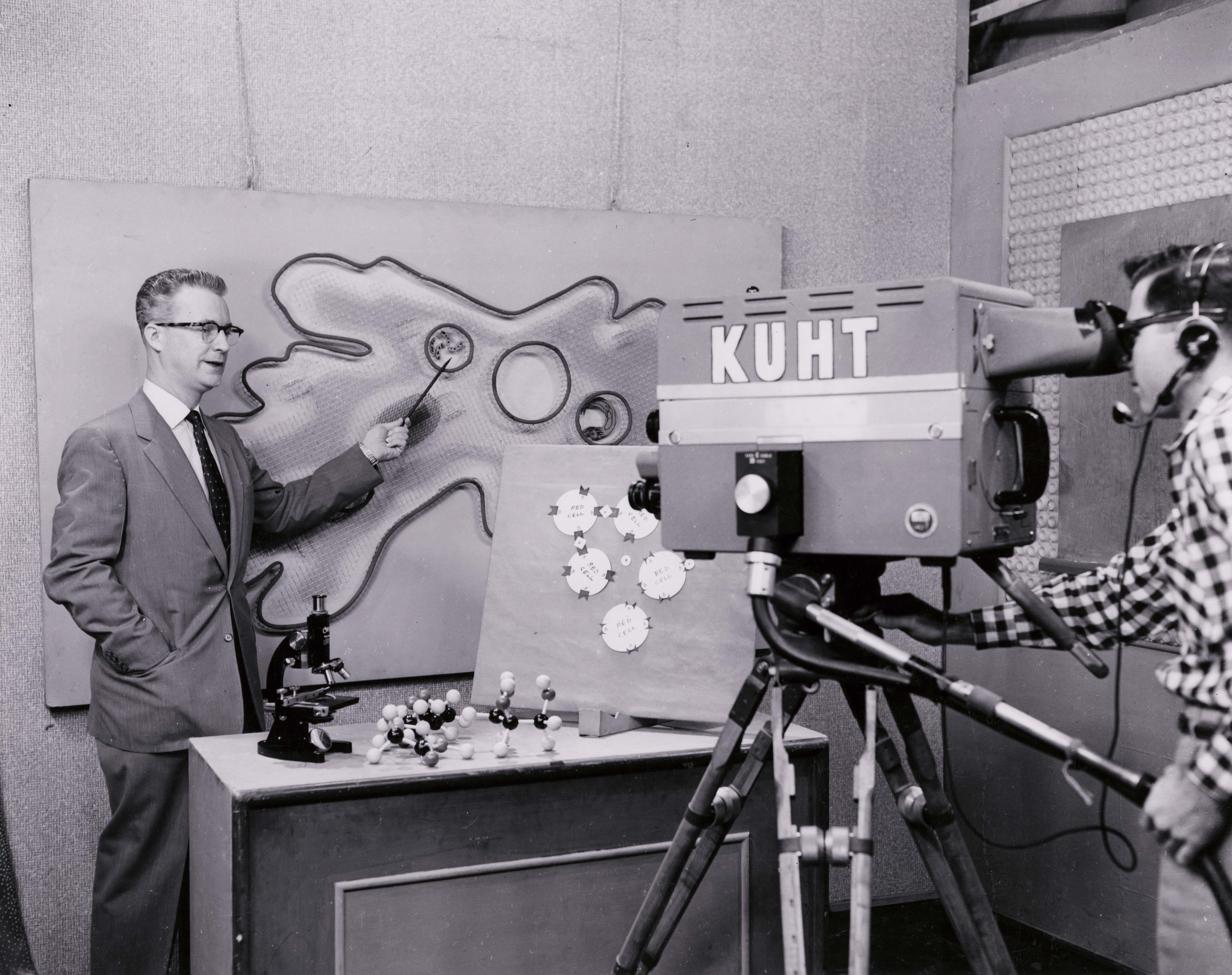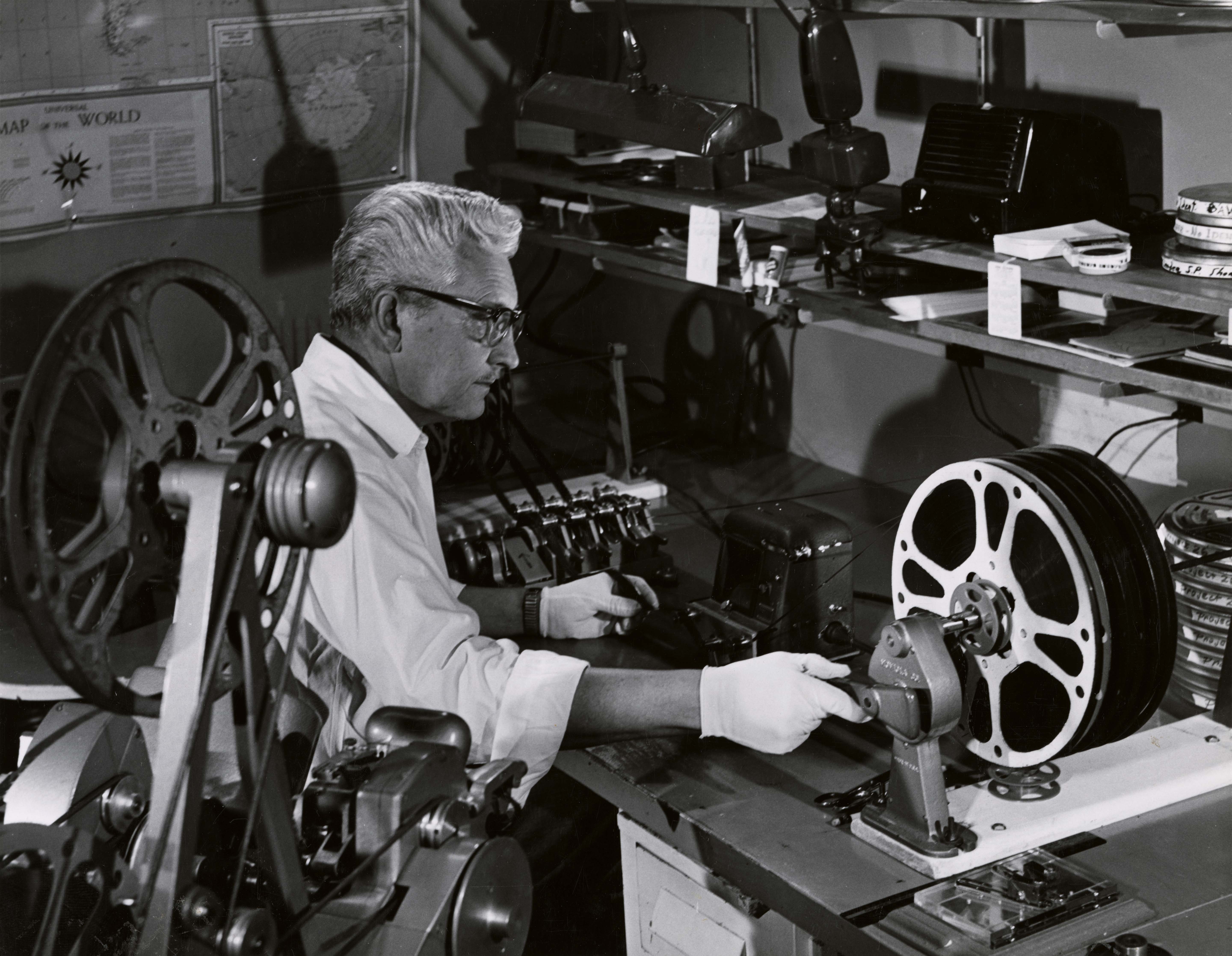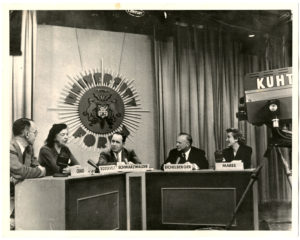
Due to the outbreak of COVID-19 (coronavirus), on-site access to Special Collections is unavailable. However, staff remain available to support teaching, learning, and research activities. We ask that researchers contact a collection curator or inquire here for assistance.
We at UH Special Collections pay tribute to Michael Galbreth (1956 – 2019), whom we have had the enormous pleasure of working with and getting to know. Galbreth and the other half of the Art Guys, Jack Massing, donated their archives to Special Collections in 2013. And just over a year ago, Galbreth donated the New Music America Collection. Galbreth organized the 1986 NMA festival in Houston and served as president of its governing board, the New Music Alliance, from 1986 to 1989. A finding aid is available for this collection.
Through photographs of materials that Galbreth has donated to UH Special Collections–particularly from the recently acquired New Music America Collection–we aim to highlight the stories that they tell. A number of institutions and individuals have also commemorated the importance of Galbreth’s life to Houston and the art community, including:
- Remembering The Art Guys’ Michael Galbreth (University of Houston)
- Pay Attention: What I Learned from Michael Galbreth (Glasstire)
- Art Guys legend Michael Galbreth dies (Houston Chronicle)
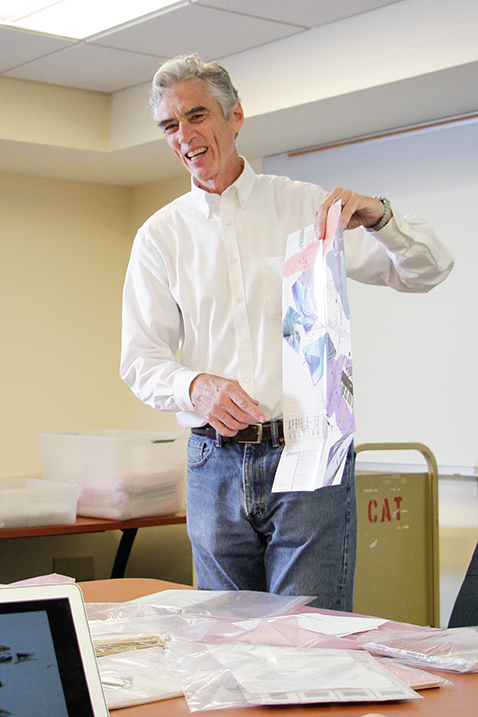
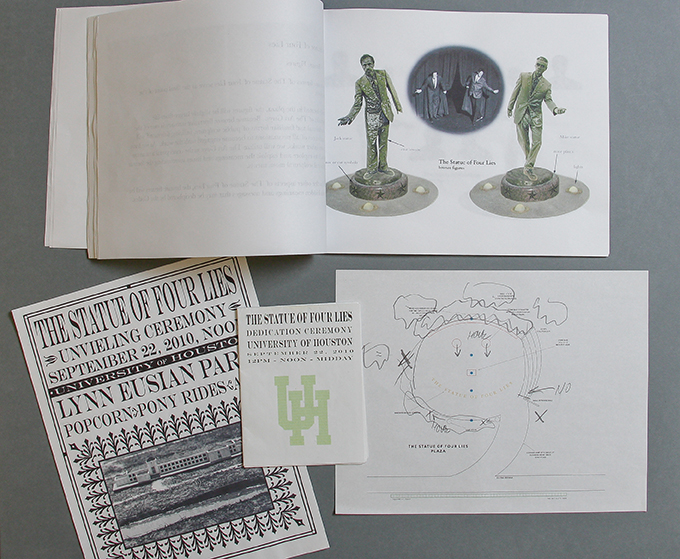
Among the approximately 84 boxes (and over a terabyte of electronic files) that make up The Art Guys Records are materials documenting the creation of The Statue of Four Lies, part of the UH Public Art collection. This selection of items shows an early mockup of the plaza where the statue is installed in Lynn Eusan Park. Other items include the proposal for the statue and a flyer and invitation to its unveiling.
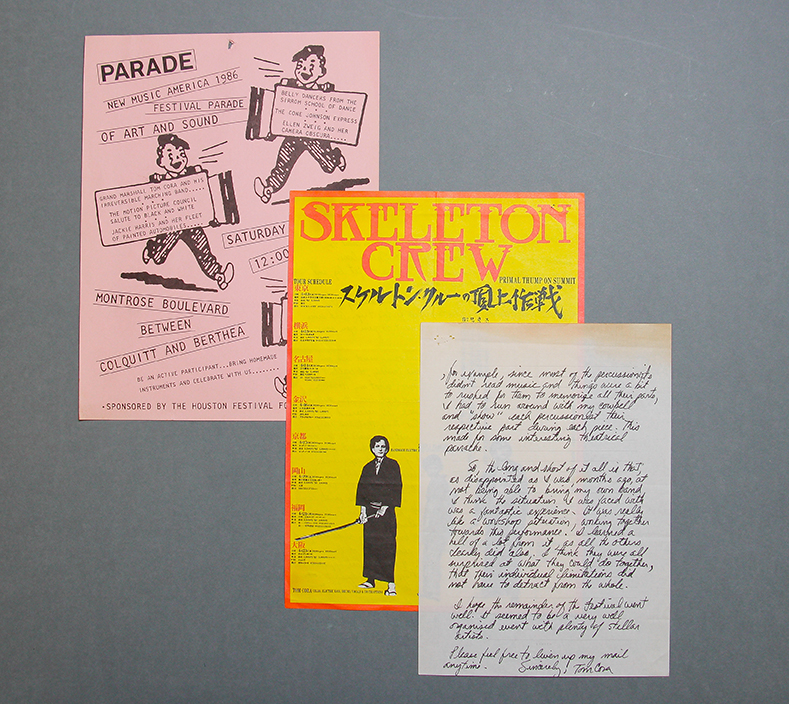
These items from the New Music America Collection document a parade with the Irreversible Marching Band led by musician Tom Cora during the 1986 NMA Festival held in Houston in 1986. Included are a flyer advertising the parade, which happened on April 5, 1986, and a two-page letter to Galbreth (one page on the back of a tour schedule for Cora’s band Skeleton Crew). In the letter, Cora writes: “Did you see the parade? The marching band was somewhat of a rag-tag unit, to be sure; but I couldn’t have been more pleased with the experience. What my Houston musicians lacked in musical skills and experience, they certainly made up for in enthusiasm and hard work.”
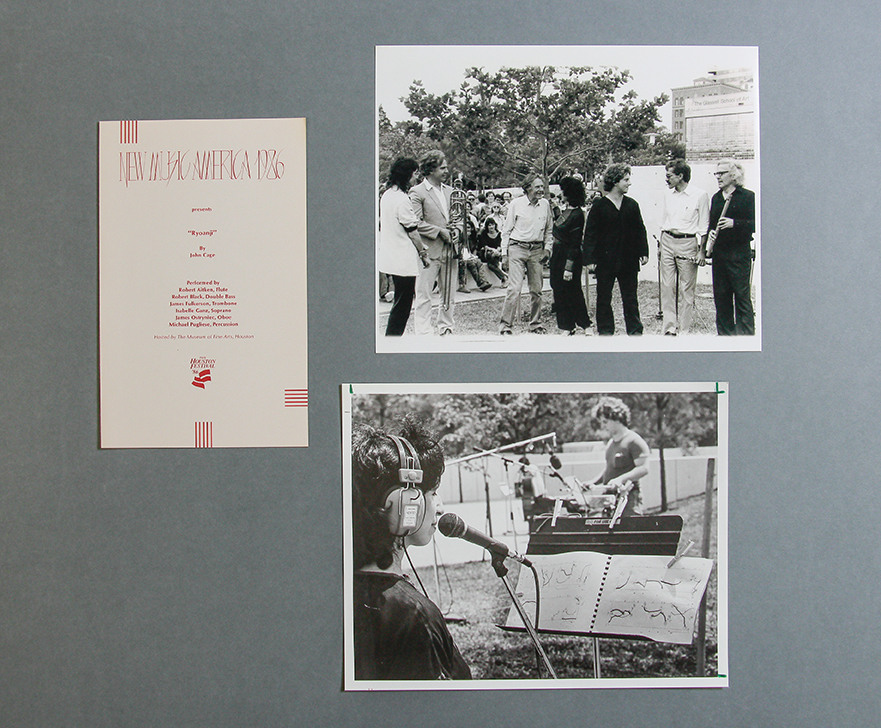
The 1986 New Music America parade culminated at the grand opening of the Cullen Sculpture Garden at the Museum of Fine Arts Houston, where John Cage performed. Included in this image are a program of the NMA event for Cage’s “Ryoanji” and two photographs, one of Cage and the musicians who performed with him that day and another of soprano Isabelle Ganz in front of Cage’s score.
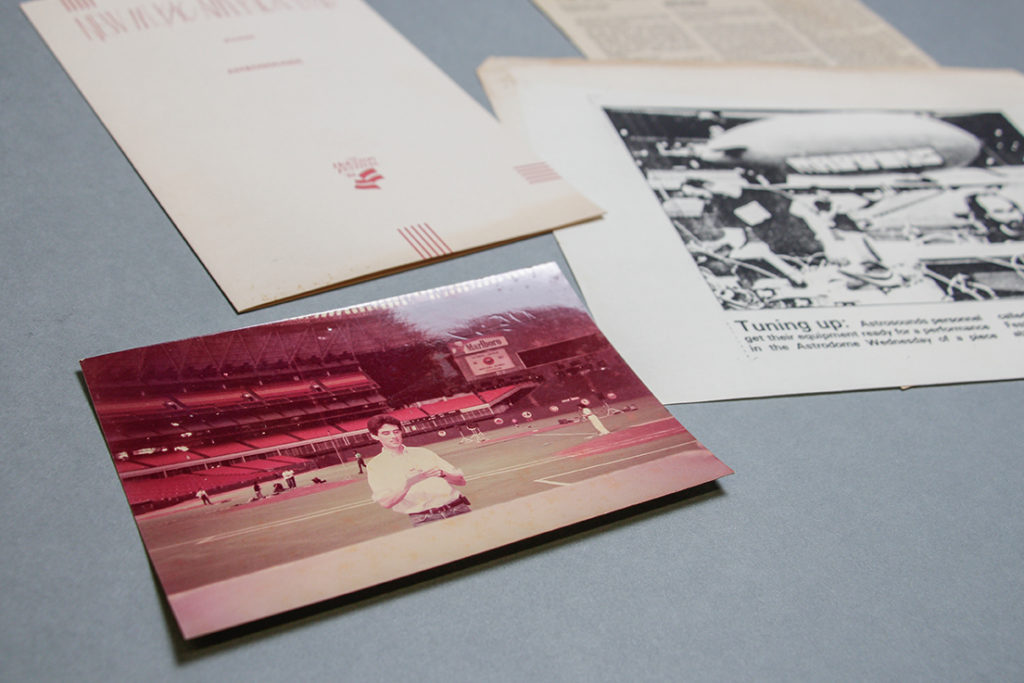
Among the Houston NMA events was Astrosounds, an experimental music concert inside the Astrodome that included a performance in which Russell Frehling launched a blimp equipped with a microphone, monitoring radio waves and feedback patterns in the space. Pictured here are a program, news clippings, and a photograph of Galbreth in the Astrodome on the day of the performance.
University of Houston Libraries Special Collections is pleased to announce the recent addition of 112 digitized films from the KUHT Film and Video Collection to the Audio/Video Repository. The films, dating between 1953 and the 1970s were digitized with the generous support of the CLIR Recordings at Risk grant. These films represent some of KUHT-TV’s earliest productions and include examples of the United State’s nascent educational and public television system.
KUHT’s first aircheck took place on May 25, 1953. The station began broadcasting the following month, making it the United States’ first educational, non-profit television station to go on air. KUHT was a pioneering influence in the field of “tele-education,” creating for-credit college courses. Included in these recently digitized materials are several of Dr. H. Burr Roney’s biology courses, which went on the air in the station’s first year. By 1958, the freshman biology telecourse “had the greatest enrollment of any standard college course given by television at any school in the nation.” ¹
In the 1960s, KUHT moved away from the production of for-credit college courses but continued to produce elementary education programs in partnership with the Houston Independent School District, as well as content for the enrichment of all viewers. Many KUHT productions documented the activities of the University of Houston and the Gulf Coast region.
Highlights include from the recently digitized materials include:
- Episodes of Target Delinquency, a series produced to inform viewers about the threat of juvenile delinquency with funding from President Kennedy’ Juvenile Delinquency and Youth Offenses Control Act of 1961.
- Episodes of The Way It Is, which educated viewers about financial issues facing consumers
- Surprisingly engaging live kinescope recordings of meetings of the Houston Independent School District
- Campus activities and events such as campus scenes from the 1950s, a university promotional film, the UH football team, and members of the UH dance team.
In 1955 KUHT welcomed a very special guest to their studio on the University of Houston campus. Eleanor Roosevelt, who had stepped down from her role as the first United States Representative to the United Nations Commission on Human Rights two years earlier,¹ was visiting Houston to speak at a luncheon sponsored by the American Association of the United Nations Association. During her brief visit, Roosevelt found time to make an appearance on KUHT’s University Forum, a panel discussion show that was simulcasted on television and KUHF-FM on Friday evenings to a typical audience of 120,000 – almost 20% of the Houston population. Hosted by KUHT founder John C. Schwarzwalder, the show was the only local affairs show that discussed international affairs.²
Roosevelt’s stop in Houston was featured in her daily newspaper column, My Day, which was syndicated six days a week from 1935 to 1962. She comments on the merits of the University of Houston’s television program, the prominence of beef on the dinner menu, and the landscape around Houston.
Jan 12: After the television program on which we appeared at the University in Houston on Saturday we came back to the hotel and had a steak dinner because that seemed to be expected of us. They put on the menu four different kinds of beef.
It was interesting to see the program at the university directed by a girl student. The cameras and all other equipment also were managed by students. A faculty advisor was there and, of course, our moderator was the head of the department. This is very good training and the authorities at the university are proud that they sent 76 of their graduates into commercial positions this past year.
The country just outside Houston is rather gloomy, I thought, flat and very unattractive. As you progress on your journey (Added: toward Dallas), however, you find a little more rolling country and it looks more friendly. Most of the land which is not occupied by oil fields is grazing ground for cattle.
To learn more about Roosevelt’s trip to Houston, check out the Rice History Corner blog posts (and comments!), The Great Eleanor Roosevelt Mystery Solved! and “our day in Houston was a very successful one, 1955”.
_________
¹ “United States Ambassador to the United Nations Human Rights Council,” Wikipedia. https://en.wikipedia.org/wiki/United_States_Ambassador_to_the_United_Nations_Human_Rights_Council
² Hawes, W. (1996). Public television: Americas first station: An intimate account. Santa Fe (N.M.): Sunstone Press. pg. 44.
Karla A. Lira is a Ph.D. History student at the University of Houston. Lira’s research focuses on multi-racial dynamics of Latinos and Blacks in the space of Basketball during the 1960s. Her current project, “True We’ll Ever Be,” sheds light on the social relations Latinos and Blacks had in the city of Houston and the University of Houston Basketball Program through oral interviews. She was kind enough to share some of her research with us below.
“And to thy memory cherished, True we’ll ever be.”
HOUSTON, March 2019 — After the Spirit of Houston band finished the last stanza, first comes Galen Robinson Jr., then Armoni Brooks, followed by Corey Davis Jr., and the rest of the Men’s Basketball team to “The Cage,” the specially designated courtside student seating section, to high five all the student fans in a new cougar tradition. Black, Latino, Asian, all races celebrate together at the Fertitta Center as the University of Houston, one of the most diverse universities in the nation, celebrates another victory.
This freedom of celebration, race inclusion, and community was not always the case.
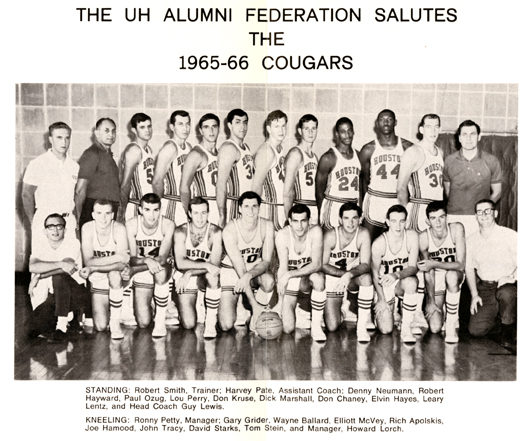
from the UH Alumni Federation Basketball Appreciation Dinner program (1966), Athletics Department Records
In 1962, the university integrated and signed the first African-Americans, Elvin Hayes and Don Chaney to play basketball. The social transition was eased by various people including Coach Guy V. Lewis, Harvey Pate, and student manager Howard Lorch. These individuals challenged the societal prejudice against the Black community. As Elvin “BIG E” Hayes recalled, student athletes such as Don Chaney, Warren McVea, and others helped create this integrated environment which everyone can enjoy.
Because of Houston’s unique history of desegregation and racial dynamics, I am researching Latinos in the basketball sphere. I am building my research on Katherine Lopez’s Cougars of Any Color: The Integration of University of Houston Athletics, 1964-1968, which emphasizes the many facets of racial integration at the university’s athletics program in the 1960s. I am also using The University of Houston Athletics Department Records in Special Collections where I have found pamphlets, donor records, and program guides that have uncovered race relations during the Civil Rights Era at University of Houston. My research breaks the Black and white racial dynamics by adding Latinos into the conversation.
The hardships of Hayes, Chaney, and McVea’s experience have set the pathway for diverse athletes to be here. This 2019 season is special. The UH Men’s Basketball Team won the regular season American Athletic conference championship, were the first to make it to the NCAA Sweet 16 since the Phi Slama Jama reign, were the first in the history of the institution to host ESPN’s College Game Day, and were one of the seven teams chosen by the NCAA to be part of their March Madness Confidential Series. The Cougars broke several records; Corey Davis Jr. has scored more than 1,000 points, making him the 48th player to accomplish this at the institution. The eccentric senior, Galen Robinson Jr. has triumphed in over 100 victories during his time in the Cougar uniform and is still counting.
With March Madness reaching its crescendo, it is important to give credit and acknowledge those that broke the racial barrier and made it possible for student athletes, coaches, staff, and students to come together and enjoy this communal winning moment. Go Coogs!
Special thanks to Elvin Hayes and Howard Lorch. Your kindness is felt.
